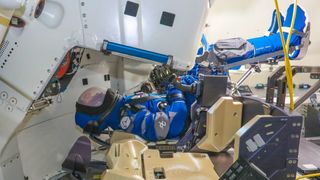Rosie the Rocketeer: Meet the dummy flying on Boeing's OFT-2 test flight this week
Rosie is set to lift off on Thursday (May 19).

First there was Rosie the Riveter. Now, meet Rosie the Rocketeer.
A World War II recruitment campaign icon will be repurposed for spaceflight once again in the form of Rosie the Rocketeer, a dummy astronaut set to take flight this week.
Rosie's mission is to strap into the commander's seat of Starliner, Boeing's astronaut taxi, for Orbital Flight Test-2 (OFT-2), an uncrewed mission poised to launch to the International Space Station on Thursday (May 19). She will be part of a larger mission to certify Starliner for human spaceflight, with hopes to start ferrying people later in 2022.
OFT-2 will be Rosie's second spaceflight, after providing valuable test data during the first Starliner mission, OFT-1, in December 2019. While OFT-1 didn't meet its objective of docking with the International Space Station, the 180-pound (82 kilograms) Rosie did her job, collecting data on the flight from 15 sensors to inform how the stresses of spaceflight affect astronauts.
"Rosie’s first flight provided hundreds of data points about what astronauts will experience during flight, but this time she'll help maintain Starliner’s center of gravity during ascent, docking, undocking and landing," Melanie Weber, Boeing's subsystem lead for crew and cargo accommodations on the commercial crew program, said in a press release about Rosie in 2021.
In photos: Boeing's Starliner OFT-2 mission in pictures
Live updates: Starliner's OFT-2 mission

Rosie the Rocketeer's namesake was inspired by a recruitment campaign during World War II. With millions of American men serving overseas, the gap in the labor force was so great that an unprecedented courting of women began. (Women were previously discouraged from joining many types of factory work.)
Get the Space.com Newsletter
Breaking space news, the latest updates on rocket launches, skywatching events and more!
Most Americans today recognize Rosie the Riveter from a series of posters, including one by J. Howard Miller with the tagline, "We Can Do It!" released in 1942. There was also a song, "Rosie the Riveter," released by Redd Evans and John Jacob Loeb around the same time. (Sample lyrics: "She's making history / Working for victory / Rosie the Riveter.")
That said, the Rosie we see today in Miller's posters is not her original identity; she acquired the moniker later, partly through happenstance. The original Rosie appeared on a cover for the May 29, 1943, issue of "The Saturday Evening Post" magazine. On the cover, iconic artist Norman Rockwell depicted a female riveter with the name "Rosie" on a nearby lunch pail, according to the Department of Defense.
The U.S. Department of Labor suggests the Miller poster's identity transformation happened in part because the owner of The Saturday Evening Post refused all reprints of the Rockwell cover, fearing claims of copyright infringement. So, instead, reprintings happened of the Miller poster, which didn't have such copyright concerns.
Regardless of Rosie's origin story, the recruitment campaign met its goal: "The campaign brought millions of women out of the home and into the workforce," the Department of Labor added, although it didn't mention that such gains were temporary, as men returned starting to work in 1945, reclaiming many of their original positions.
"To this day," the department added, "Rosie the Riveter is still considered the most successful government advertising campaign in history."
Rosie the Rocketeer will sport a blue spacesuit and red polka-dot head scarf, the scarf being a nod to the Miller poster. She will also don a face mask hand-sewn by Mae Krier, a "real-life Rosie" who built B-17 and B-29 aircraft in a Boeing factory in Seattle at age 17, Boeing said. Krier's service there stretched from 1943 to 1945.
Krier, now aged 96, recently supported the passage of the Rosie the Riveter Congressional Gold Medal Act through Congress, in association with Pennsylvania Sen. Bob Casey and Rep. Brian Fitzpatrick. The act collectively gives a Congressional Gold Medal to all of the women who built aircraft, weapons, ammunition and motor vehicles during World War II.
"When I started the important work of getting our Rosies recognized 30 years ago, I never gave up," Krier said in a February 2021 Boeing release. Krier's autographed, hand-sewn Rosie the Riveter scarf will also fly with Rosie the Rocketeer in honor of all the riveters like Krier.
Like many astronauts, Rosie has been waiting a while for her OFT-2 flight. Boeing pulled Starliner off the launch pad in August 2021 to address a valve issue, delaying the launch by more than eight months. With a fix in place and a slot now cleared for Starliner to launch, Rosie will be back on board to see space for a second time soon.
Follow Elizabeth Howell on Twitter @howellspace. Follow us on Twitter @Spacedotcom and on Facebook.
Join our Space Forums to keep talking space on the latest missions, night sky and more! And if you have a news tip, correction or comment, let us know at: community@space.com.

Elizabeth Howell (she/her), Ph.D., is a staff writer in the spaceflight channel since 2022 covering diversity, education and gaming as well. She was contributing writer for Space.com for 10 years before joining full-time. Elizabeth's reporting includes multiple exclusives with the White House and Office of the Vice-President of the United States, an exclusive conversation with aspiring space tourist (and NSYNC bassist) Lance Bass, speaking several times with the International Space Station, witnessing five human spaceflight launches on two continents, flying parabolic, working inside a spacesuit, and participating in a simulated Mars mission. Her latest book, "Why Am I Taller?", is co-written with astronaut Dave Williams. Elizabeth holds a Ph.D. and M.Sc. in Space Studies from the University of North Dakota, a Bachelor of Journalism from Canada's Carleton University and a Bachelor of History from Canada's Athabasca University. Elizabeth is also a post-secondary instructor in communications and science at several institutions since 2015; her experience includes developing and teaching an astronomy course at Canada's Algonquin College (with Indigenous content as well) to more than 1,000 students since 2020. Elizabeth first got interested in space after watching the movie Apollo 13 in 1996, and still wants to be an astronaut someday. Mastodon: https://qoto.org/@howellspace
